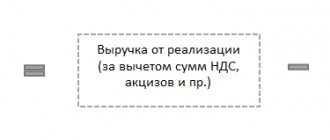How to decrypt balance line 1370
Line codes commonly used in accounting are specified in Appendix No. 4 of Order No. 66n of the Ministry of Finance. Otherwise, this line is referred to as “Uncovered loss” (NU) or “Retained earnings” (NP). In fact, it indicates how many NU or IR fell on the date that turned out to be the reporting date.
To take into account this line, account 84 NU is used, which is prescribed in the Chart of Accounts.
It is important to take into account here that only the positive or negative balance that has accumulated here until the end of the year is recorded on this account. But if the report is not prepared for this date, then not only this account is filled out, but also 99, which is directly related to the “Profit and Loss” section. By the way, it is on it that positive and negative amounts related to account 99 accumulate throughout the year (for example, this includes fines that are imposed for incorrect accounting).
If a loss is reflected on the line as of the reporting date, it is marked not with a minus sign, but with parentheses - for example (9,000).
By the way, interim dividends not paid for the entire year are indicated in parentheses () on a separate line in the third balance sheet section. If this is line 1371, then dividends are taken into account in the line “including interim dividends”. Only then will the report be executed correctly and show up-to-date data.
Is retained earnings an asset or a liability?
Retained earnings on the balance sheet are, of course, a liability. The value of this indicator indicates the company’s actual debt to its owners, since ideally this profit should be distributed among the participants and invested in the further development of the business.
In fact, the company cannot dispose of retained earnings without the owners making a decision. The loss reflected in line 1370 is also on the passive side of the balance sheet, only this is a negative value, so the number is placed in parentheses.
Our article “How to read a balance sheet (a practical example)?” will help you better understand balance sheet analysis.
Component strings
As we have already found out, in the column with line 1370 the amount of uncovered loss or the amount of retained profit should be entered.
The period for which this amount accumulated and how much it amounted to during the reporting period is indicated:
Both the pros and cons are not listed on the same line. There is a separate account for each of them.- The report indicates not only the amounts accumulated from ordinary transactions, but also the amounts that are directly related to this group.
The amounts obtained by plus or minus are calculated using a special formula. To make the calculations, you need to calculate the net amount of profit or loss for a specific period. This includes those amounts that remained in the report after taxation. These amounts will be useful to fill out the line.
Indicators for investors
When analyzing the financial condition of a company, investors pay attention to the use of retained earnings. If NP accumulates and is not put into circulation, this state of affairs should seem to suit investors, since they can count on significant dividends.
However, without investment in its activities, the company stops growing, and its income not only does not increase, but may also decrease (due to a drop in competitiveness, high wear and tear of equipment, and for other reasons related to the lack of investment). So a company that accumulates profits but does not invest in its activities cannot be attractive.
At the same time, a company that does not make a profit and does not pay dividends cannot interest investors at all.
The ideal option for investors is a company that invests the funds remaining after paying dividends in its development. Although the owners may decide not to pay dividends and direct the entire volume of NP into circulation.
The concept of NP
So, what is meant by this definition? In accounting, this is, of course, a liability, since it includes the share of capital of the persons who own the property. Yes, while this profit is not aimed at any specific goals, but a well-written accounting report quickly resolves this issue.
NP is a kind of reserve that is distributed at the discretion of the owners and resolves pressing issues.
Typically, the profit received is used for the following purposes:
You can put money into investments, improving production and making it more cost-effective and advanced- Another option is to buy assets that will generate profit in the future
- You can also pay dividends
- And finally, you can create reserves or replenish existing ones
The liability can be used only after a meeting of owners has been held and it has been decided what it will be used for, and the direction of the funds will be noted in the minutes. NP is noted in article 1370 in the corresponding section “Capital”. There is also a loss here.
So, as you probably already understood, NP is the amount that remains after paying taxes. The definition is very close to the concept of net profit. And if during the year the organization has not accrued dividends and has no tax debts, then the NP will become net profit.
True, there is some difference here. NP shows the result not only for a specific period, but also for the entire period of operation of the company as a whole. While the state of emergency is responsible only for a specific period. Accordingly, accountants interpret these two concepts differently.
The video will tell you what retained earnings are:
How retained earnings from previous years are displayed
Retained earnings from previous years are accumulated in account 84. The balance on the credit of this account is transferred to balance sheet line 1370. Typically, there should be no movement in the debit of the account during the year, since profit distribution traditionally occurs at the end of the year after the annual meeting of the company's owners.
For information on how data on retained earnings is generated for reflection in the balance sheet (final and interim), read the article “Procedure for compiling a balance sheet (example).”
Definition of uncovered loss
If in the case of a profit the company remains in the black, then in the case of a loss, on the contrary, it is in the minus. However, both items are indicated in account 84, which is absolutely necessary to show the movement of funds in one direction or another. Let's look in more detail at what NU is.
NU is the cost of losses, which is indicated in accounting and differs in that it is not covered by sources of funds that are the property of the company.
This amount is determined taking into account how many tax payments and other consumables were made during the selected period. During the report, the minus amount is indicated on the NU account and recorded in the debit account. And those amounts contributed to cover the minus are indicated on the loan. The balance is entered either in the asset of the balance sheet (in fact, the total amount will be increased by this amount), or in the liability of the balance sheet with a decrease in the amount that the loss brought.
Write-offs from NU for the required period of time are reflected in line 84 of NU in correspondence with the following accounts:
- Line eighty or “Authorized capital”. If the value of NU is brought to the value of the company’s net assets, then this line must be filled out.
- Line eighty-two “Reserve capital”. It is filled out if you need to pay off the debt using reserve capital funds.
- And finally, line seventy-five or “Settlements with founders.” This line is filled in if, for example, the NU is repaid using targeted contributions from participants.
Account eighty-four is filled out so that it shows what and where the funds went.
Legislative regulation
First of all, line 1370 of the balance sheet is regulated according to the Chart of Accounts and other similar documents.
Also taken into account is Order of the Ministry of Finance No. 66n, which also determines exactly how these columns are filled out. Naturally, the rules according to which accounting is conducted are also taken into account.
Examples of accounting for line 1370
Let's look in more detail at several examples related to accounting for excess money on the balance sheet or, conversely, a loss.
So, example 1.
Let's assume that in 2021 the amount of profit that the company received from the sale of fur products amounted to 2 million rubles without VAT. At the same time, the cost of all these knitted products cost the company half of this amount (this included the purchase of yarn, machine maintenance, delivery, and so on). As for all the other costs of the company, they cost it 70 thousand rubles.
Accordingly, in the section with business transactions you will need to write down Dt 90.9, Kt 99. At the same time, the company’s net profit accounted for nine hundred and thirty thousand. Accordingly, it is this amount that will equal the organization’s net profit.
However, we should not forget that the company also had to pay taxes to the budget. It is registered in the budget as Dt 99, Kt 68. Accordingly, 186 thousand rubles will go to the tax office from net profit. This is the amount needed to pay all taxes.
After the accounting report was compiled, the accountants made the following entry: Dt 99 Kt 84. At the same time, the NP that remained with the company amounted to 744 thousand rubles. This is exactly how much net money the company has left after paying all taxes to the state.
It turns out that according to the results of the balance sheet, the amount of 744 thousand rubles will appear in line 1370.
Unfortunately, everything is not always so rosy - there are times when, on the contrary, instead of profits, losses appear. This is exactly the option we will consider in example 2.
After the company had been operating for a whole year, losses were identified in its activities. At the beginning of 2021, their size was 40 thousand rubles. Based on the results of the accounting, a meeting was convened, in which it was decided that the losses would be repaid through targeted funding.
In this case, business transactions will look like this: Dt 50 Kt 75.
Of the 40 thousand, fifteen founders contributed in cash. Accordingly, Dt 51 Kt 75.
As for the rest of the amount, which is equal to 25 thousand rubles, it was deposited into the bank account. Accordingly, Dt 75 Kt 84.
It turns out that the founders contributed 40 thousand to cover the loss and bring the account to a positive balance.
Postings in accounting
For balance sheet reformation, two indicators are used, for write-off of losses - four indicators.
For the first indicator the following data is used:
- For retained earnings, the figures used are Dt 99/Kt 84
- If a NU is found, then it is designated as Dt 84/Kt 99
For the second option, please provide the following information:
- If NU is written off at the expense of profits received in previous months, then this is indicated by the numbers Dt 84/Kt 84
- When repaying the authorized capital, the numbers Dt 82/Kt 84 are entered
- If the minus was financed by the owners, then the indicators are set to Dt 75/Kt 84
- And finally, when bringing it to the size of net assets, Dt 80/Kt 84 is set
It is these indicators that are usually found as postings most often. However, due to the fact that the loss can be compensated for in other ways, there are other postings.
What is line 1370: calculations
It is very easy to calculate this indicator - you need to take the account balance. 84 NU or NP for the selected period of time (year or some other time period). For calculations, you need to calculate how much profit or, conversely, losses that remained with the company when all taxes were paid.
The information obtained will be useful to fill in the required fields. But remember that the exact amount can only be obtained after deducting taxes.
Video with guidance on submitting a balance sheet:
So, as you probably already understood, filling out line 1370 is not that difficult. The main thing is to determine what exactly happened to the company’s budget during the reporting period. Did it bring profit, or, conversely, did the company report only a loss?
Accordingly, if the company had a profit, then you need to decide what it will do. If, on the contrary, there is a loss, then you need to decide how the company will compensate for it.
Top
Write your question in the form below
Retained earnings: calculation formula
According to general accounting data, retained earnings are a company's net profit after taxes that can be distributed to the company's owners.
Based on global financial practice, retained earnings (hereinafter referred to as RR) are calculated using the following formula:
NPk = NPn + PE – Div,
Where:
NPk - NP at the end of the reporting year;
NPn - NP at the beginning of the reporting period;
PE - net profit remaining after accrual of income tax;
Div - dividends paid in the reporting year based on the NP of previous years.
If you do not have the NP value, then to calculate the NP you can use the following scheme:
- first calculate profit before tax (to determine it, calculate operating profit, which is defined as the difference between operating income and operating expenses);
- then subtract depreciation and interest costs from operating profit;
- Subtract tax from the resulting profit value.
To find out whether it is possible to see the amount of operating profit in the accounting statements, read the article “Which line is operating profit reflected in the balance sheet?”




